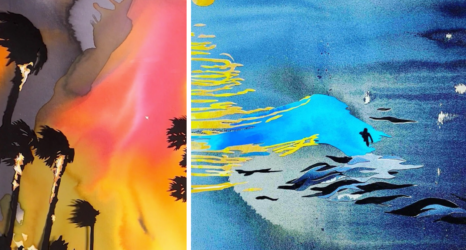Ms. April
When April weeps, the tears drip on her toes,
the water rises in the jade-stone lake,
a blue jay shakes the red-bud blooms awake,
in rainy light, the green grass rosy glows.
A “girlie calendar” makes one think of men’s lockers, walls of auto repair shops or a military barracks: They’re typically collections of nude or scantily dressed women in provocative poses, designed for the male heterosexual gaze.
But what if a girlie calendar is designed with a lesbian gaze in mind? That sort of subversion is what lesbian poet Mary Meriam has in mind with the title of her poetry collection, Girlie Calendar, and for the Ms. Blog she is excerpting from the book a poem-of-the-month (she began in October and continued in November, December, January, February and March). Meriam is also selecting accompanying artwork for each month from both historical and contemporary lesbian-related images.
April’s artist, Patricia Cronin, creates compelling works in a variety of media, many with social-justice themes focusing on gender and sexuality. Slyly reinvigorating traditional images and art historical forms with contemporary content, her critically acclaimed statue “Memorial To A Marriage,” a three-ton Carrara marble mortuary sculpture of her partner (now wife) and herself, was first displayed before same-sex marriage was legal anywhere in the U.S. An art professor at Brooklyn College, CUNY, as well as a trustee of the American Academy in Rome, Cronin’s works are in numerous collections and she exhibits widely. Her solo show “Shrine For Girls, Venice” is a “collateral event” in the 2015 Venice Biennale.
In 2009 Cronin compiled Harriet Hosmer, Lost and Found, A Catalogue Raisonné, which was both a book and a Brooklyn Museum exhibit featuring Cronin’s take—through painted images and art-historical research—on mostly forgotten American sculptor Harriet Hosmer (1830-1908). Hosmer moved to Rome in 1852 and lived among a community of British and American artists and writers and a circle of learned and well-to-do “independent women” (Hosmer is assumed to have been a lesbian). She had an important career, was praised by critics, won competitive commissions and earned enormous sums for her sculptures. By creating a catalogue raisonné, Cronin was able to examine the histories of art and women at the intersection of the ivory tower and the marketplace.
Above is Cronin’s monochromatic watercolor of Hosmer’s “Oenone,” in which themes of abandonment, betrayal and rejection are palpable. (Oenone was the wife of Greek mythology’s Paris, who deserted her for Helen of Troy; she was also the subject of a poem by Tennyson.) As critic Charlie Fitch wrote in Artnet of Cronin’s Hosmer recreations,
I marveled at the completeness of such a project that would subsume any artist without the bright, marathon spirit of the indefatigable Cronin. Her pictures add a shade of vulnerability and pathos to the residue of Hosmer’s fame, but they also, by their very existence, seek to restore Harriet’s glory. Let this be the beginning of a wider search into the buried past of the great women artists, of whom Patricia Cronin is one.
Permission to reprint the painting from artist Patricia Cronin
Poet Mary Meriam is the founder of Lavender Review, cofounder of Headmistress Press and author of The Countess of Flatbroke, The Poet’s Zodiac, Word Hot, Conjuring My Leafy Muse and Girlie Calendar.





